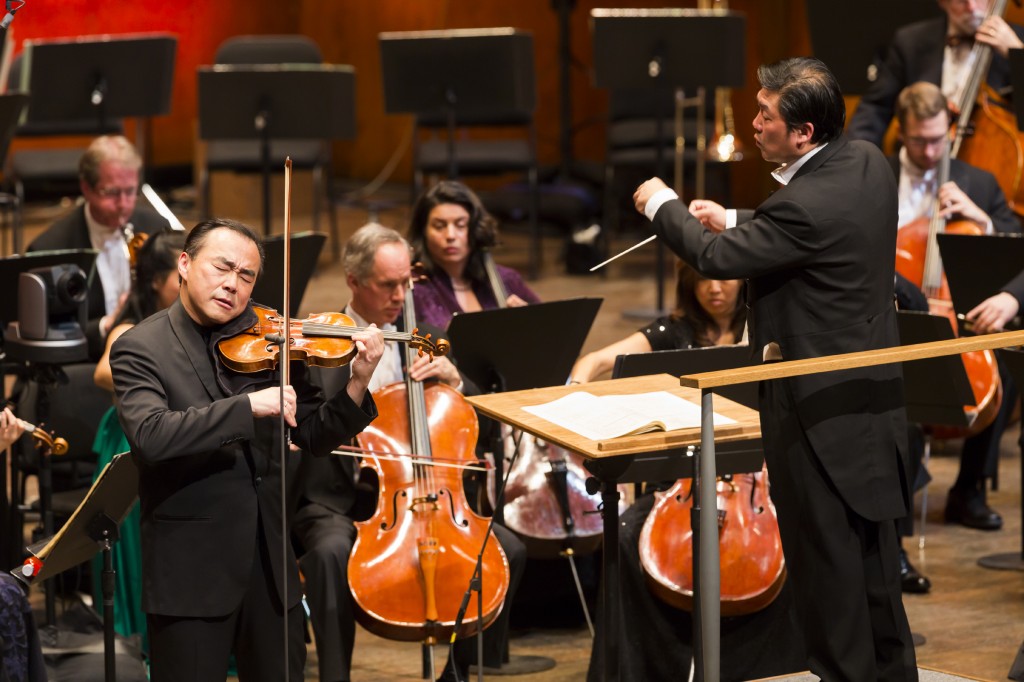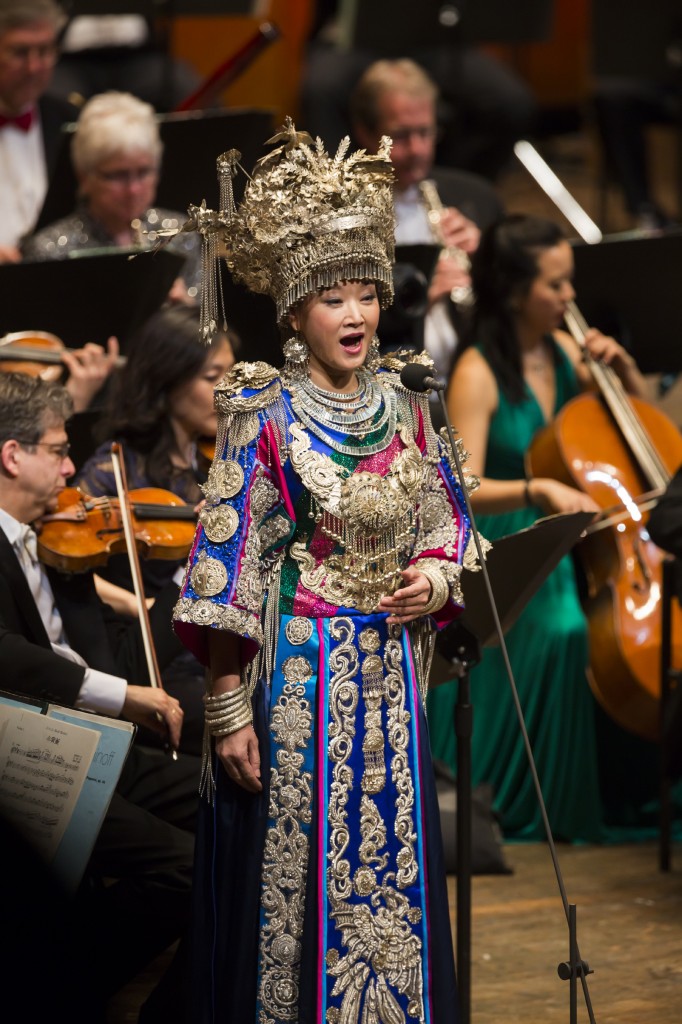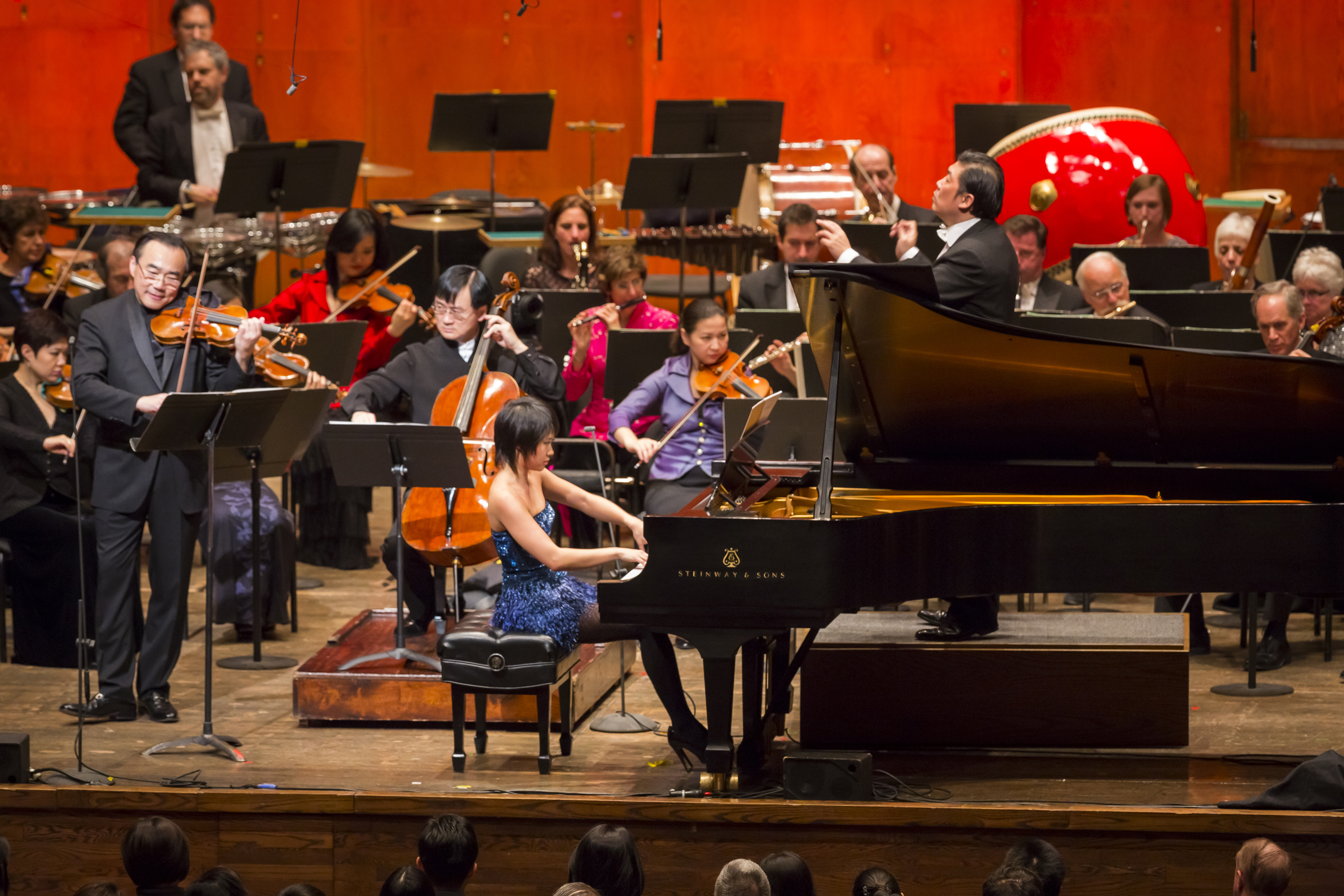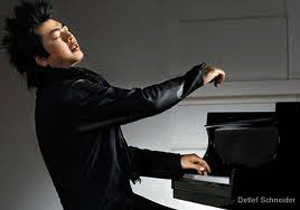There were no indications that this was a special Chinese New Year Concert except for two huge golden balloons of beautiful horses placed on a ledge outside the hall and visible from both inside and outside. This–among other things this evening–was very tastefully done.

Cho-Liang Lin, violin; Long Yu conducts the New York Philharmonic in a Chinese New Year celebration at Avery Fisher Hall, 2/1/14. Photo by Chris Lee
The Concert opened with “The Triple Resurrection” for Violin, Violoncello, Piano and Orchestra (2013) by Tan Dun of “Crouching Tiger, Hidden Dragon” fame. It is a one-movement work with no tempo indication and is a salute to Wagner’s Ring Cycle. It didn’t hold together very well and appeared to be an eclectic mix of sounds and styles. For sure, it wasn’t Beethoven’s Triple Concerto, which is undoubtedly a masterpiece. Yet Dun’s work did utilize all the program’s soloists (except the singer), and this was a great way to tie the musicians together. After this collaboration, Yuja Wang–who is fast becoming a star–performed solo. The problem here–in a performance of Rachmaninoff’s Paganini Variations–was one of balance, as there were times when Wang was completely inaudible. Yet when I heard her in Tchaikovsky’s Piano Concerto No. 1 with another orchestra in another hall, I heard every note! Was she tired here? Was the orchestra just too overpowering? Hard to say. When she was audible–mostly in the quiet, lyrical sections or high up on the keyboard where her magnificent fingers shined through with incredible clarity and scintillating playing–there were gorgeous moments that made one’s heart melt.

Song Zuying, vocalist & Long Yu conducts the New York Philharmonic in a Chinese New Year celebration at Avery Fisher Hall, 2/1/14. Photo by Chris Lee
The Chinese conductor, Long Yu, holds many posts in his native land, where he is chief conductor of the China Philharmonic Orchestra which he co-founded in 2000, and music director of the Shanghai and Guangzhou symphony orchestras. Mr.Yu played a leading role in creating the Shanghai Orchestral Academy as a partnership between the Shanghai Symphony Orchestra, the Shanghai Conservatory and the New York Philharmonic. Maestro Yu has commissioned many works from well-known composers–both Western and Chinese–as well as appearing with the world’s leading orchestras and opera companies. His conducting was very confident, solid and professional.
After Intermission, we heard “Spring Festival Overture” by Li Huanzhi, composed in 1955-56, which opened the “China in New York Festival” in January of 2012 and was conducted by Maestro Yu. It is rather old-fashioned and Romantic, sounding like the music of Antonin Dvorak. The well-known violinist Cho-Liang Lin, born in Taiwan, did in fact perform the music of Dvorak: the lovely and subdued Romance for Violin and Orchestra in F minor, Op.11 (1873/77). Lin is a poetic, mature artist who lives up to his superb reputation. A wonderful surprise was the cellist Jian Wang (no relation to Juja Wang), who was brilliant, extremely musical, and sensitive in the “Variations on a Rococo Theme” for Cello and Orchestra, Op.33 (1876). Wang has a gorgeous sound. It isn’t surprising to read that while a young student at the Shanghai Conservatory, he was featured in the documentary film “From Mao to Mozart: Isaac Stern in China”. Stern promptly selected him out of a large group of young musicians and got the support for him to study with the great teacher and cellist Aldo Parisot at the Yale School of Music.
Last on the program was vocalist Song Zuying . Wearing traditional dress, she sang Chinese folksongs which were well orchestrated and extremely well received–especially by the Chinese members of the audience, who understand this type of high-pitched nasal singing. She was clearly a big hit, and the orchestra had an encore ready for her, which was happily performed and applauded. I think if overtime had been allowed, each soloist could have given encores! It was a revealing concert that showed an important musical evolution: how Chinese artists have become solid interpreters of western music. I look forward to the Philharmonic’s next Chinese New Year Concert!


